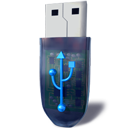It’s not unusual these days to have computers, consoles and tablets in the house, all running different operating systems. If you want your external drive to be interoperable between them, you’ll need to think carefully about your choice of file system. I’ve broken down some popular options here so you can make the best choice for your drive. (Note – many Android phones support USB On The Go, which means you can plug USB drives right in via an adapter.)
| Windows | Mac | Linux | Android | Chrome OS | iPad | Xbox 360 | PS3 | |
|---|---|---|---|---|---|---|---|---|
| FAT32 | Yes | Yes | Yes | Yes | Yes | Sort of [1] | Yes | Yes |
| exFAT | Yes [2] | Yes | No [3] | Yes | No | No | No | No |
| ext3 | Sort of [4] | Sort of [5] | Yes | No [6] | Yes | No | No | No |
| NTFS | Yes | Sort of [7] | Yes | Sort of [8] | Yes | No | No [9] | No |
| HFS+ | No [10] | Yes | Sort of [11] | Sort of [8] | Sort of [12] | Sort of [1] | No | No |
- iPads (not iPhones) can read FAT and HFS drives via the Camera Connection Kit, but only photos and some videos. If you’re looking to access an MP3 or a Word document, you’re out of luck.
- exFAT works on Vista / Windows 7 / Windows 8, but XP needs this update first.
- Not by default, but you can add FUSE and read and write as usual.
- Windows can read ext2 / ext3 / ext4 drives, but only using 3rd party software like explore2fs, Ext2Fsd or Ext2IFS.
- Not by default, but you can enable read/write using OSXFUSE with fuse-ext2, or buying Paragon.
- Not on a stock Galaxy S3, but some custom ROMs do support this.
- Macs can read NTFS drives by default. You can enable writing to NTFS using OSXFUSE with NTFS-3G, or buying software like Paragon or Tuxera.
- On Android, the Paragon app will enable access to NTFS and HFS.
- This might seem odd, but it’s true – NTFS is not supported on the Xbox 360.
- Not by default, but you can buy extra software to enable it.
- Works for every flavour except journaled HFS+, which is read only. (Unfortunately, journaled HFS+ is the default for drives formatted with a Mac.)
- Works, but read only for journaled HFS+.
FAT32
If you buy a smaller drive or USB stick, it’s probably formatted by default as FAT32 because it is the most compatible – pop a FAT32 disk into pretty much anything, and it will just work, including devices not listed here like TVs or cars. However, there are some important limitations which mean that it’s not always the best answer.
- The volume has to be smaller than 2TB. If your drive is larger, e.g. 3TB, it will need to be split into two volumes before the full size can be accessed.
- Files on the drive can only be 2GB or smaller. (Hence, large video files or databases are a problem.)
- It is the least fault tolerant of these file systems, so not a great option for storing important data over a longer term.
- FAT32 is not open source (if that matters to you).
exFAT
exFAT is made for external drives, just like FAT32. It’s a newer standard, so it’s not as widely compatible, and it’s also Microsoft proprietary. However, it can deal with volumes bigger than 4GB and files sizes larger than 2GB.
ext2, ext3 and ext4
These three file systems are closely related and native to Linux and the open source world. If you’re an Ubuntu or Chrome OS user, these are the best options for you – Ubuntu formats drives by default in ext4.
NTFS
NTFS has been the default file system on Windows machines for many years, and Linux based systems can work very well with them – however, it’s still tough to use on a Mac.
HFS and HFS+
Journaled HFS+ is the default format for drives on OS X, but it’s hard to use on other systems.
What is the best solution?
Most people will still use FAT32. If you buy a smaller USB data key, that’s probably what it’s formatted as by default, simply because it works with so many systems. However, it’s not ideal, and the demands of bigger drives or better security may leave you looking elsewhere.
First, there are two alternatives to using an external drive. One – upload your files to cloud storage like Google Drive / Dropbox / Skydrive, and use their app on Mac / Windows / Xbox or wherever you need. Two – keep your files in the house on a NAS and access this via DLNA, Samba or even a specialised application like Plex.
Given how many different systems many of us use at the same time, choosing a file system should be easy, but it’s surprisingly tricky. It’ll get easier – as our internet connections get faster and more ubiquitous, cloud storage access will become the best solution for more and more of us.

Leave a Reply